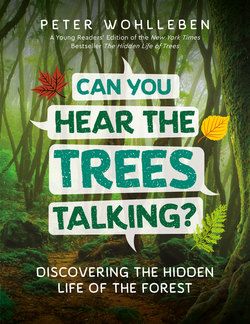Читать книгу Can You Hear the Trees Talking? - Peter Wohlleben - Страница 22
На сайте Литреса книга снята с продажи.
ОглавлениеMost trees like to live
in
families, and in each family there are–of course–children!
That's why trees work to grow strong–so they can have babies. You can see this
for yourself when they're
in
bloom.
Pine trees release so much pollen,
it can look like a cloud of dust.
share the same "house," so
to speak. With some trees,
such as the willow, trees are
either male or female—the
male trees produce pollen and
don't grow blossoms, and the
female trees grow blossoms
and don't produce pollen—
but this is the exception.
After the female blossoms are
successfully pollinated, seeds
develop, By fall the seeds
of beech and oak trees are
mature, and they drop to the
ground,
where many hungry
animals are waiting for these
delicious treats. Wild boars
IN
THE
SPRING
IT
CAN
BE
dusty under trees, and you
may find your shoes covered with a layer of tiny,
yellowy-green particles. That's male pollen—
tiny grains that want to land on female blossoms.
Pollen grains are carried by the
wind,
so they can't
really seek out blossoms
themselves.
When
they meet
a female blossom, it's by accident. That's why
a
tree
must produce
a
huge amount of
pollen,
so
that
a
few
grains will reach their
goal.
With most trees, the female blossoms are on
the same tree that produces the male pollen, They
in particular adore beechnuts and acorns because
they're full of fat
and oil
that help
them
build up
a
thick
layer of fat of their own. This way the animals carry
their winter food supply under their
skin,
and they
can go for
a
few days without finding anything to eat.
*
Tree parents aren't too happy about
all
this because,
after all, their children are supposed to grow from
these
seeds,
That's why
some
trees,
such
as
beeches,
decide among themselves when they will bloom.
Some years their branches have no seeds, and many
wild boars don't survive the winter. But every three
to five years, all the beech trees bloom like crazy at
the
same
time.
There are lots of
beech nuts—so
many
that the wild boars can't eat them all.
We don't know how trees communicate with each
other over hundreds of miles to coordinate when they
will and will not bloom. (You're going to be seeing
more of these we-just-don't-knows in the course of
this book, because we still have so much to learn
about what goes on in the forest.)
*
With beeches and
oaks,
the seeds fall straight down
from the mother
tree.
That way the tree family stays
together nicely. But some tree species are loners.
Willows, poplars, and birches like to stand on their
own,
To make
sure
their
children
can grow up faraway,
they produce seeds that are very tiny and covered
with small hairs or
fluff,
so they can be easily caught
up in a gust of wind and carried several miles away.
Other seeds, such as those of maples or many
conifers, are too big and heavy to simply blow away.
So these trees have come up with another strategy:
each seed is equipped with wings. That way the seed
can spin like a helicopter propeller in the air. Even
without a motor, the seed can slowly float to the
ground,
and if it's caught up in
a
strong
wind,
it can
fly
a
few hundred yards.
Tree Seeds
LARGE SEEDS WITHOUT WINGS OR FUZZ prefer to
fall beneath their mother tree. Beechnuts, for
example, like to stay close to home. Smaller
seeds with propellers, like the maple seeds
pictured
here,
or tiny, fluffy seeds like those of
the willow, fly far awory from the mother tree.
The children of these trees don't mind growing
up without family close by.
